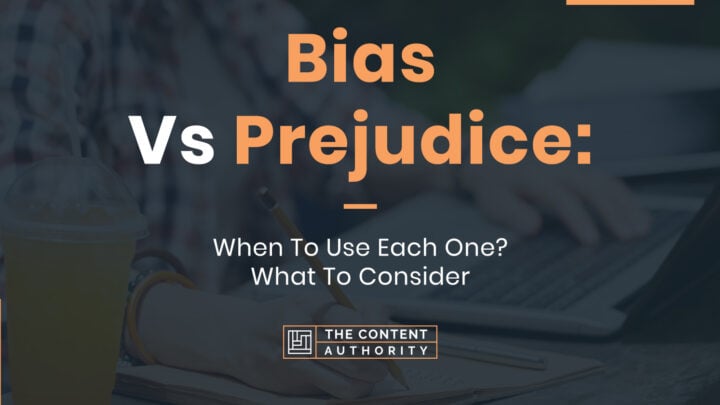Have you realized that some people use the words bias and prejudice interchangeably? However, these words have very different meanings. So, when it comes to bias vs. prejudice, which term should you embrace, and what’s the in-depth meaning of each word?
Bias refers to an individual or group’s thoughts leaning towards a specific area of life, like religion, society, or politics. In contrast, prejudice is the process of decision-making and judgment forming with a premature mind or making up facts instead of knowing the truth about a thing/person.
Bias and prejudice seem like complex terms at first sight. However, if you take the time to research these words, you will realize how interesting they are. This post will have a detailed explanation of the usage and meanings of the words bias and prejudice.

Definitions Of Bias And Prejudice
It is impossible to explain the difference between words if you do not know their definitions. The definitions will showcase the specific things that set apart confusing words like bias and prejudice. This section explains the definitions of bias and prejudice from different sources. Here is a comprehensive overview of that:
What Is The Definition Of Bias?
Bias is an inclination towards something, like a preference or partiality towards a person or an item. Here is an example in a sentence, “The bias in the president’s judgment was so clear to the citizens.”
In the textile sector, bias is a diagonal line sandwiched between weft and warp in a knitted cloth. For example, in a sentence, “The bias on the fabric was so prominent.”
Also, in textiles, a bias is a cloth that looks like and it’s removed from a garment to reduce or diminish its circumference. An Example in a sentence is: “The seamstress will diminish the dress’ waist by taking out the bias.”
In electronics, bias is a voltage or current applied to an electric device like a junction transistor electrode to alter its operational point to the chosen part of its transfer role. In a sentence, “The electronic applied bias to the device to correct its functional defaults.”
In statistics, bias is the difference between the prospect of the estimator model and the true population value that diminishes the representativeness of the estimator by altering it methodically. For example, in a sentence, “The statistics are incorrect because of the sample bias.”
In sports, bias is a weight added to one side of a bowl in the game of crown green bowls to ensure it follows a curved path as it rolls. This is the oldest definition of the word bias, coined in the 1560s. However, it no longer applies in modern English.
As an adjective, bias means “inclined to one side/ swollen on one side.” In a sentence, “We plan to take down the bias wall at the back of the house.” It is also an adjective for “something, like a cloth cut slanting or diagonally.” In a sentence, “Kindly fetch me the bias piece of cloth.”
What Is The Definition Of Prejudice?
Prejudice is an adverse judgment or opinion formed without knowledge of facts. Here is an example in a sentence, “The investigators do not want to prejudice the investigation.”
Another dictionary defines prejudice as any preconceived opinion or feeling. It can be negative or positive. An example in a sentence is: “June left her job because of prejudice in the workplace.”
Another definition of prejudice is an irrational hostile attitude, hatred, or fear towards a specific race, religion, society, or group. Let’s look at a sentence example, “The unreasonable prejudice towards Islam has caused a lot of unrest.”
Prejudice is an opinion or judgment formed without due examination of facts, leaning towards one side. It is often unreasonable and not formed on just grounds or with sufficient knowledge. For example, in a sentence, “While passion and prejudice often mislead Marcus, he is an empathetic and honest man.”
As a verb, prejudice means “to harm or negatively impact someone’s position or chances.” In a sentence, “The police will prejudice the constituent’s view of the force.”
How To Properly Use Bias And Prejudice In A Sentence
Bias and prejudice have multiple meanings. Therefore, there is more than one context where you can apply them. Below are some things you must bear in mind when using bias and prejudice in a sentence:
How To Use The Word Bias
Use the word bias as a noun in the following contexts:
- Referring to a presumption or prejudice for or against a person or group
- Referring to an affinity or habitual inclination to something.
- Discussing something without balance
- An opinion or view formed or expressed without fact
- A misleading account
- A directional diagonal fabric weave
- An unjust act
You can also use this word in a sentence as a verb in the following contexts:
- To skew towards a particular direction
- To cause a profound effect
- To corrupt or prove harmful
Bias is both a countable and an uncountable noun. Therefore, its plural forms are “bias’ and “biases.” As a verb, this word has other word forms. For example, the past tense “biased,” third-person singular simple present indicative form ‘biases,” and the present participle “biasing.”
How To Use The Word Prejudice
Use this word as a noun in the following contexts:
- Referring to a dislike or hostility from preconceived or unfounded opinions
- An intense dislike
- A state or quality of being specious
- Physical damage caused to something
- A disparaging act
Bias Vs. Prejudice: Consider The Following When Using These Words
Before you start using these words in sentences, there are a few things you should know. Here are some of those considerations:
Pronunciation
Learning pronunciation before using a term in sentences is wise because it will give you the confidence to use it in verbal conversations. So, the correct pronunciation for the word bias is “/bahy-us/.” On the other hand, the proper pronunciation for the word prejudice is “/prej-uh-dis/.”
Spelling
Something else worth considering when using these words is the spelling. Embracing proper spellings will help you convey the correct message in written text. Therefore, it would be wise to rehearse the spelling as much as possible.

List Of Examples Of Bias And Prejudice In Sentences
Sentence construction is a significant part of communication. Also, communication is all about sharing and receiving messages that you understand. Unfortunately, you cannot communicate efficiently if you do not understand a particular word.
So, now that you understand these words, you should have no problem using them in sentences. Here are some examples that should be a good read:
Example sentences of the word bias
- The phrase in the book’s second chapter accurately describes the author’s prevalent bias.
- Mark’s natural bias was to leave things as they were.
- The tailors will reduce the dress’s waist by tearing off its bias.
- The constructors have instructions to break down the bias wall at the corner.
- Cate’s bias affects his relationship with the constituents
Example sentences of the word prejudice
- The parents do not want to prejudice the investigation by talking to the witnesses.
- The prejudice in the workplace caused more than half of the company’s employees to resign.
- It is unreasonable to express prejudice toward a person because of their heritage.
- Prejudice is one of the greatest causes of strife in society.
- Male prejudice affects a lot of women in the tech community.
Conclusion
Bias and prejudice are commonly used in literary works. Now that you know their meanings, you will have an easier time reading and using them. We hope we have improved your understanding of these two confusing English words.
Shawn Manaher is the founder and CEO of The Content Authority. He’s one part content manager, one part writing ninja organizer, and two parts leader of top content creators. You don’t even want to know what he calls pancakes.

